Global cold laser therapy market is estimated to be valued at USD 123.7 Mn in 2025 and is expected to reach USD 170.7 Mn by 2032, exhibiting a compound annual growth rate (CAGR) of 4.7% from 2025 to 2032.
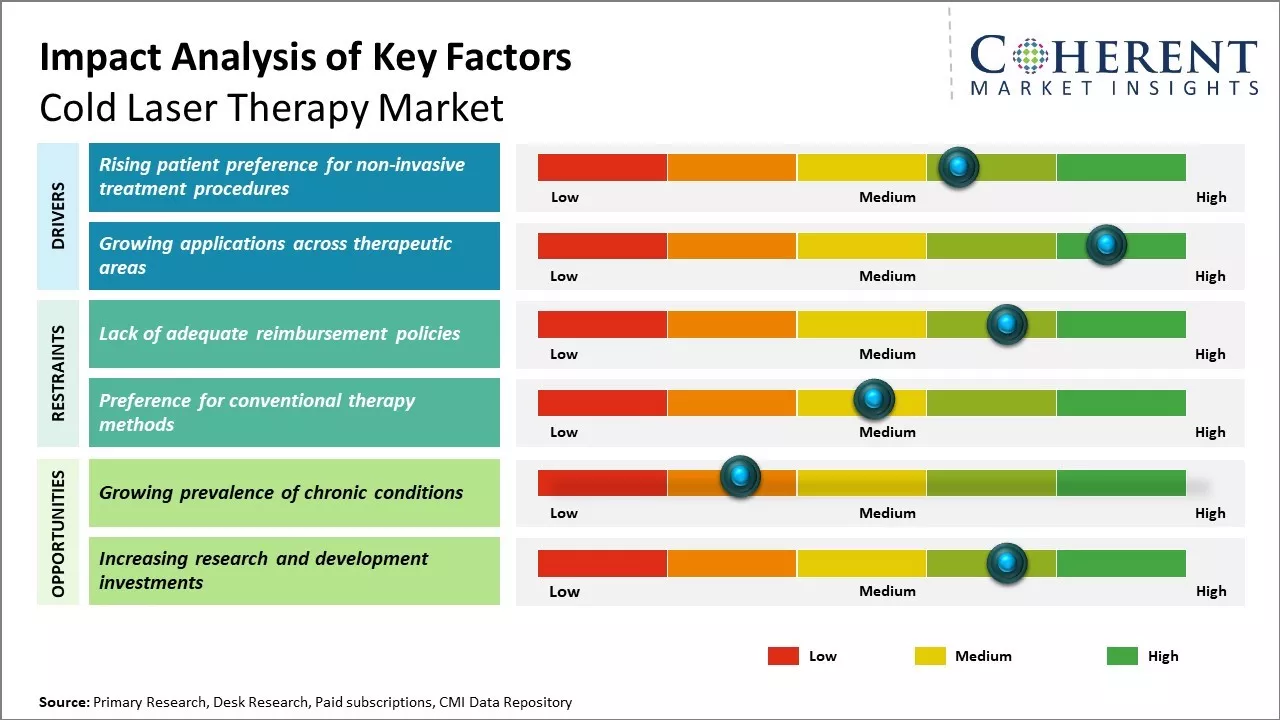
Discover market dynamics shaping the industry: Request sample copy
Global cold laser therapy market growth is driven by rising incidences of musculoskeletal disorders and injuries. The demand for non-invasive treatment options for pain management is increasing. Cold laser therapy provides relief from joint pain, muscle strains and other conditions without any side effects. It helps to treat acute as well as chronic pain, and is being increasingly used in physiotherapy centres and clinics. Growing awareness about the benefits of cold laser therapy and rising geriatric population prone to orthopaedic complications boosts demand for cold laser devices in the near future.
Rising patient preference for non-invasive treatment procedures
Cold laser therapy has gained immense popularity as a preferred mode of treatment for various medical conditions due to its non-invasive nature. The therapy involves the application of low-level laser energy to the injury site, which accelerates the natural healing process of the body through photochemical reactions. It does not require any incision or surgery and allows for pain-free treatment sessions. Patients are increasingly opting for non-surgical alternatives due to the associated advantages like lower risks of complications, minimal post-treatment care requirements, faster recovery times and avoidance of hospital stays. Cold laser therapy addresses this rising demand by providing pain relief and therapeutic effects for injuries or afflictions like arthritis, muscle strains, tendonitis, and others without requiring intake of oral medications or complex procedures. This has made it a suitable replacement for several invasive therapies.
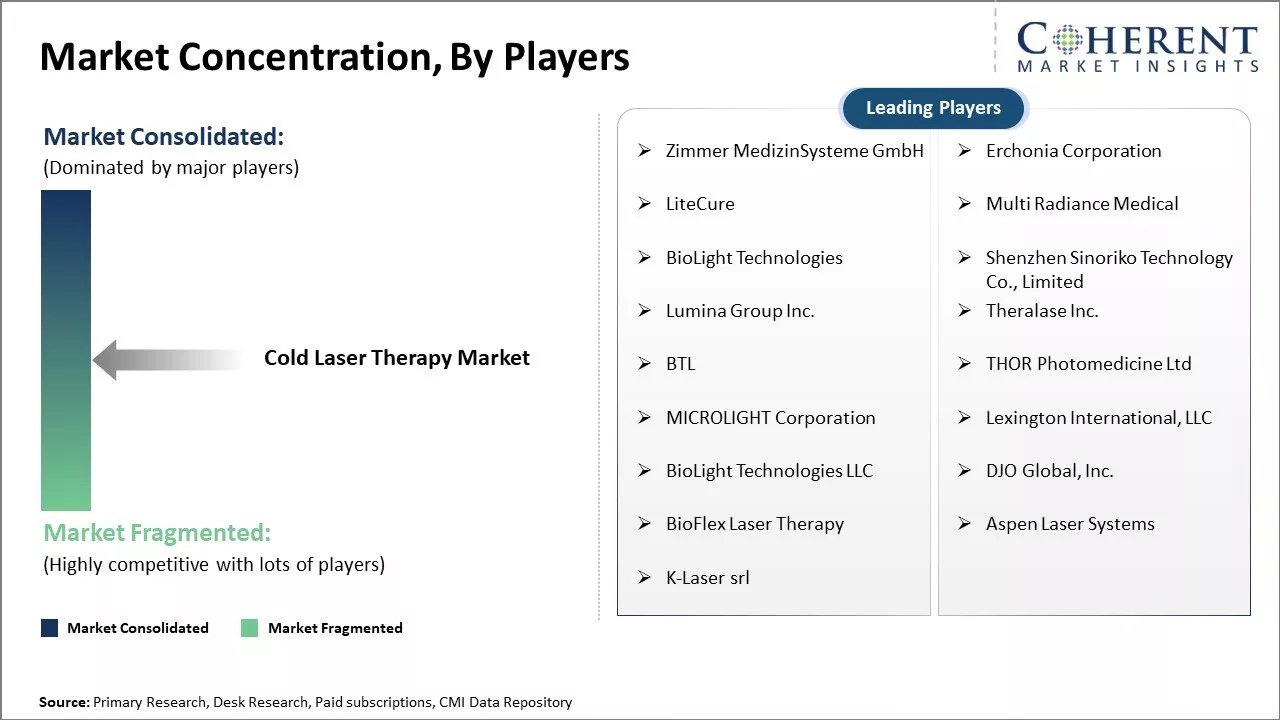
Get actionable strategies to beat competition: Request sample copy
Growing applications across therapeutic areasTraditionally used for treating pain and inflammation, ongoing research has enabled its utility in a diverse range of medical disciplines. New therapeutic uses that are contributing to increasing relevance of cold laser therapy include wound healing, dental problems, lung disorders, erectile dysfunction and sports injuries. Multiple clinical trials have demonstrated its efficacy for improving symptoms, speeding recovery and replacing other expensive treatments in these areas. Its adoption is further propelled by the development of compact and multi-application devices that allow convenient home-based therapy.
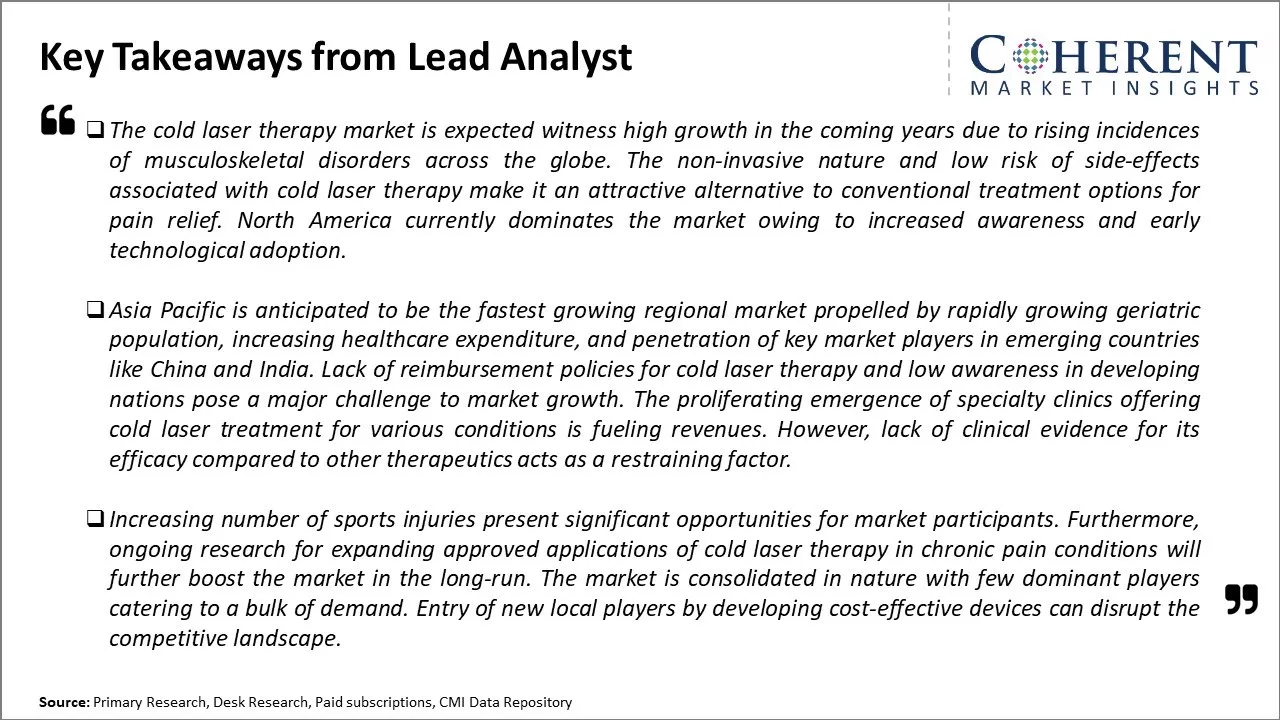
To learn more about this report, Request sample copy
Market Challenges – Lack of adequate reimbursement policiesGlobal cold laser therapy market faces some challenges due to less awareness and adoption. As this therapeutic technique is relatively new, awareness among both healthcare providers and patients remains low. Many providers are hesitant to adopt cold laser due to lack of credibility evidence of its efficacy. Reimbursement policies vary significantly across regions and applications, creating financial barriers. Heavy investment is required for laser equipment and training, thus, restricting access in certain under-resourced geographies.
Market Opportunities – Growing prevalence of chronic conditions
Rising geriatric population and growing prevalence of chronic conditions is increasing the market for pain relief applications of cold laser therapy. Minimal side effects and non-invasiveness make it an attractive alternative to medications and surgeries. Ongoing clinical research validating more therapeutic applications would help address credibility issues. Favorable regulatory reforms improving reimbursement schemes can stimulate the market development over the forecasted period.
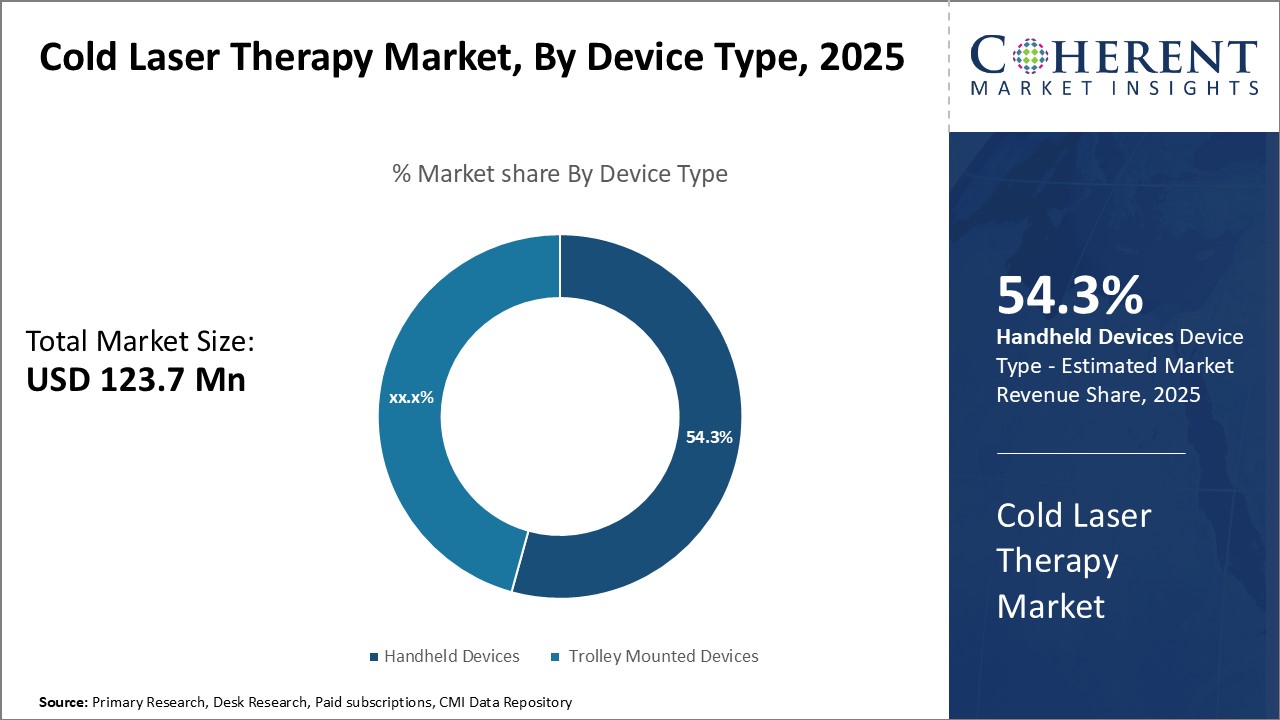
Discover high revenue pocket segments and roadmap to it: Request sample copy
Insights, By Device Type: Portability and ease of use boosts demand for handheld deviceDevice Type segment is sub-segmented into handheld devices and trolley mounted devices. Handheld devices segment is estimated to hold 54.3% share of the market in 2025. Being lightweight and compact in size, handheld devices can be easily carried and handled by both patients and therapists. This allows for cold laser therapy to be administered conveniently during home visits or while on-the-go. Unlike trolley mounted devices which are stationary, handheld devices offer therapists greater flexibility to target specific areas of the body. These are especially beneficial for treating smaller and delicate areas that may be difficult to access using larger devices. The intuitive designs of modern handheld devices also make them simple to operate for all types of users, without requiring technical expertise. This accessibility increases compliance for treatment regimens. Key players are additionally offering handheld devices with upgraded features such as different applicators and attachments, tailored for diverse therapy needs. These advantages of handheld devices have enabled their increased adoption over stationary alternatives for cold laser therapy.
Insights, By Laser Type: consistent energy flow drives preference for continuous laser systems
Laser Type segment is sub-segmented into continuous laser, pulse laser, and combination. Continuous laser segment is expected to hold 48.3% of the market share in 2025. Continuous lasers function by emitting a steady laser beam for the entire duration of treatment without any fluctuations in output. This maintains a consistent energy level and allows for deeper tissue penetration compared to pulsed options. The continuous mode of operation also helps deliver more uniform energy doses to target tissues. This is advantageous as it can aid faster healing and relieve pain more effectively. Unlike pulsed lasers which may cause sensations of heat or pain from intermittent output, continuous systems provide soothing therapy experience for patients. Continuous lasers have gained especially strong popularity for dealing with chronic conditions that require long term management through recurrent sessions. Their reliability and ease of use over long periods without technical interruptions have made continuous lasers, the laser type of choice for both therapists and patients.
Insights, By Application: Growing demand for alternative pain management drug treatment
Application segment is sub-segmented into pain management, wound healing, skin rejuvenation, inflammation, and others. Pain management segment is expected to hold 38.1% of the market share in 2025. It is effective at targeting both acute and chronic pain conditions. Being non-invasive, cold laser provides a drug-free alternative to pharmacological pain management with little to no side effects. Its mechanisms of stimulating cellular activity, reducing inflammation, and increasing production of pain-relieving endorphins help alleviate multiple types of pain including lower back pain, joint pain, postoperative pain, and neuropathic pain. Growing awareness about the benefits of cold laser therapy for pain is driving its adoption. Ease of use further promotes patient compliance in regular home-based pain management regimens. These advantages have positioned cold laser therapy as a preferred first-line or adjunct treatment across clinical settings for various pain indications.
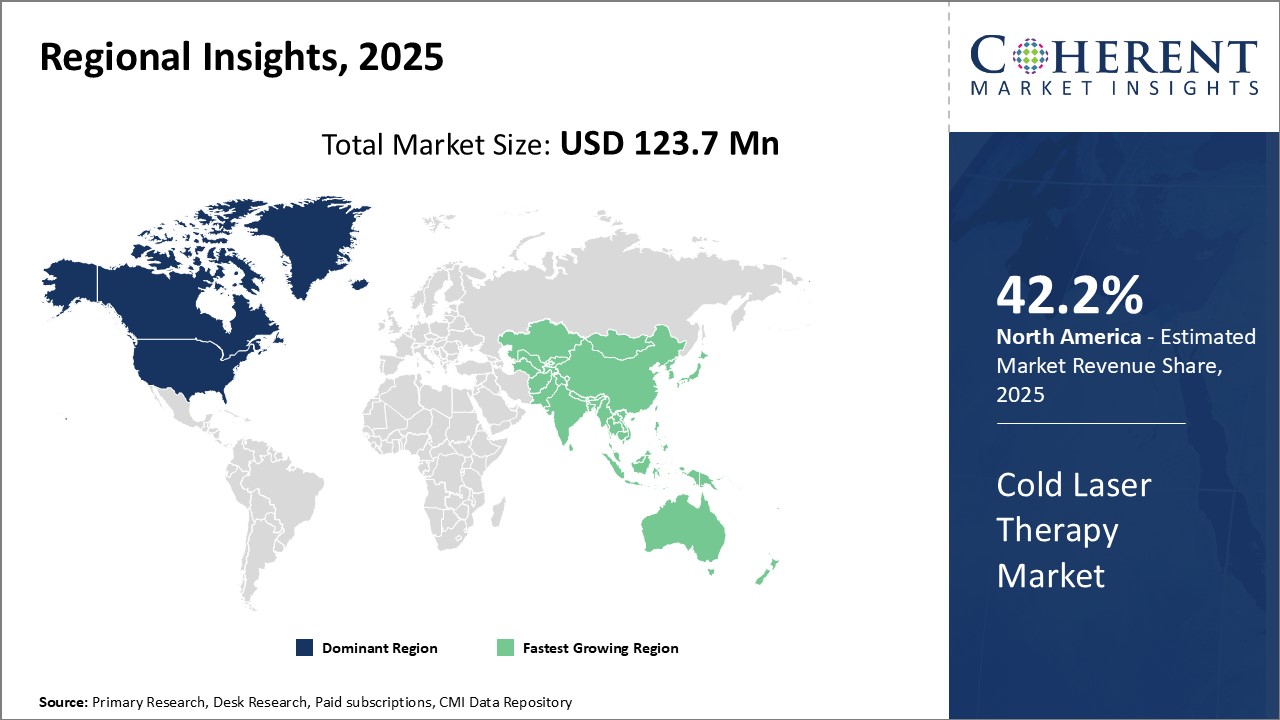
Need a Different Region or Segment? Customize now
North America has established itself as the dominant regional market for cold laser therapy globally and is projected to hold 42.2% of the market share in 2025. The U.S., in particular, has a highly developed healthcare infrastructure and rising awareness levels regarding the benefits of pain-free treatment options like cold laser therapy. Most of the leading industry players are headquartered in the US. .and have a strong hold in the regional market through extensive distribution networks across hospitals, physiotherapy clinics, sports medicine facilities and ambulatory surgical centers. Moreover, the presence of advanced research capabilities and frequent new product innovations being cleared by the U.S. FDA have enabled North American companies to consolidate their leadership position.
Asia Pacific has emerged as the fastest growing regional market for cold laser therapy in recent years. Rapid economic development and growing healthcare expenditures are driving higher investments towards modern medical technologies across developing countries like China and India. This has prompted global industry leaders to focus on Asia Pacific for market expansion through joint ventures and strategic partnerships with regional players. Local companies are also making significant R&D investments to indigenize manufacturing and gain a competitive foothold. Furthermore, rising medical tourism from developed nations is providing lucrative opportunities to hospitals and clinics in Asia to promote new therapies like cold laser.
Cold Laser Therapy Market Report Coverage
| Report Coverage | Details | ||
|---|---|---|---|
| Base Year: | 2024 | Market Size in 2025: | USD 123.7 Mn |
| Historical Data for: | 2020 To 2024 | Forecast Period: | 2025 To 2032 |
| Forecast Period 2025 to 2032 CAGR: | 4.7% | 2032 Value Projection: | USD 170.7 Mn |
| Geographies covered: |
|
||
| Segments covered: |
|
||
| Companies covered: |
Zimmer MedizinSysteme GmbH, Erchonia Corporation, LiteCure, Multi Radiance Medical, BioLight Technologies, Shenzhen Sinoriko Technology Co., Limited, Lumina Group Inc., Theralase Inc., BTL, THOR Photomedicine Ltd, MICROLIGHT Corporation, Lexington International, LLC, BioLight Technologies LLC, DJO Global, Inc., BioFlex Laser Therapy, Aspen Laser Systems, K-Laser srl |
||
| Growth Drivers: |
|
||
| Restraints & Challenges: |
|
||
Uncover macros and micros vetted on 75+ parameters: Get instant access to report
Share
Share
About Author
Ghanshyam Shrivastava - With over 20 years of experience in the management consulting and research, Ghanshyam Shrivastava serves as a Principal Consultant, bringing extensive expertise in biologics and biosimilars. His primary expertise lies in areas such as market entry and expansion strategy, competitive intelligence, and strategic transformation across diversified portfolio of various drugs used for different therapeutic category and APIs. He excels at identifying key challenges faced by clients and providing robust solutions to enhance their strategic decision-making capabilities. His comprehensive understanding of the market ensures valuable contributions to research reports and business decisions.
Ghanshyam is a sought-after speaker at industry conferences and contributes to various publications on pharma industry.
Missing comfort of reading report in your local language? Find your preferred language :
Transform your Strategy with Exclusive Trending Reports :
Frequently Asked Questions
Joining thousands of companies around the world committed to making the Excellent Business Solutions.
View All Our Clients
US Reciprocal Tax Impact Analysis On Cold Laser Therapy Market
Stay updated on tariff changes with expert insights and timely information